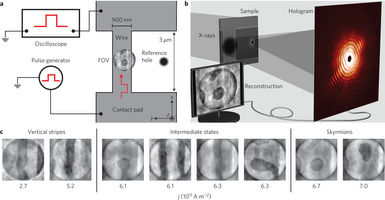R&D: Fast-Moving Magnetic Particles Could Enable new Form of Data Storage
Discovered phenomenon could provide a way to bypass limits to Moore’s Law.
This is a Press Release edited by StorageNewsletter.com on October 10, 2017 at 2:12 pmFrom MIT News Office, David Chandler
New research has shown that an exotic kind of magnetic behavior discovered just a few years ago holds great promise as a way of storing data – one that could overcome fundamental limits that might otherwise be signaling the end of ‘Moore’s Law,’ which describes the ongoing improvements in computation and data storage over recent decades.

Illustration by Moritz Eisebitt
“One of the biggest missing pieces needed to make skyrmions a practical data-storage medium,“ Geoffrey Beach says, “was a reliable way to create them when and where they were needed. So this is a significant breakthrough.“
Rather than reading and writing data one bit at a time by changing the orientation of magnetized particles on a surface, as today’s magnetic disks do, the new system would make use of tiny disturbances in magnetic orientation, which have been dubbed ‘skyrmions.’ These virtual particles, which occur on a thin metallic film sandwiched against a film of different metal, can be manipulated and controlled using electric fields, and can store data for long periods without the need for further energy input.
In 2016, a team led by Geoffrey Beach, associate professor of materials science and engineering, MIT (Massachusetts Institute of Technology) documented the existence of skyrmions, but the particles’ locations on a surface were entirely random. Now, Beach has collaborated with others to demonstrate experimentally for the first time that they can create these particles at will in specific locations, which is the next key requirement for using them in a data storage system. An efficient system for reading that data will also be needed to create a commercializable system.
The new findings are reported this week in the journal Nature Nanotechnology, in a paper by Beach, Felix Buettner, MIT postdoc, and Ivan Lemesh, graduate student, and ten others at MIT and in Germany.
“The system focuses on the boundary region between atoms whose magnetic poles are pointing in one direction and those with poles pointing the other way. This boundary region can move back and forth within the magnetic material,“ says Beach. “What he and his team found four years ago was that these boundary regions could be controlled by placing a second sheet of nonmagnetic heavy metal very close to the magnetic layer. The nonmagnetic layer can then influence the magnetic one, with electric fields in the nonmagnetic layer pushing around the magnetic domains in the magnetic layer. Skyrmions are little swirls of magnetic orientation within these layers,“ adds Beach.
The key to being able to create skyrmions at will in particular locations, it turns out, lay in material defects. By introducing a particular kind of defect in the magnetic layer, the skyrmions become pinned to specific locations on the surface, the team found. Those surfaces with intentional defects can then be used as a controllable writing surface for data encoded in the skyrmions. The team realized that instead of being a problem, the defects in the material could actually be beneficial.
“One of the biggest missing pieces needed to make skyrmions a practical data-storage medium,” says Beach , “was a reliable way to create them when and where they were needed. So this is a significant breakthrough,“ he explains, thanks to work by Buettner and Lemesh, the paper’s lead authors.“What they discovered was a very fast and efficient way to write such formations.“
Because the skyrmions, basically little eddies of magnetism, are incredibly stable to external perturbations, unlike the individual magnetic poles in a conventional magnetic storage device, data can be stored using only a tiny area of the magnetic surface – perhaps just a few atoms across. That means that vastly more data could be written onto a surface of a given size. That’s an important quality, Beach explains, because conventional magnetic systems are now reaching limits set by the basic physics of their materials, potentially bringing to a halt the steady improvement of storage capacities that are the basis for Moore’s Law. The new system, once perfected, could provide a way to continue that progress toward ever-denser data storage, he says.
The system also potentially could encode data at very high speeds, making it efficient not only as a substitute for magnetic media such as hard discs, but even for the much faster memory systems used in Random Access Memory (RAM) for computation.
But what is still lacking is an effective way to read out the data once it has been stored. This can be done now using sophisticated X-ray magnetic spectroscopy, but that requires equipment too complex and expensive to be part of a practical computer memory system. The researchers plan to explore better ways of getting the information back out, which could be practical to manufacture at scale.
“The X-ray spectrograph is ‘like a microscope without lenses“ explains Buettner, “so the image is reconstructed mathematically from the collected data, rather than physically by bending light beams using lenses. Lenses for X-rays exist, but they are very complex, and cost $40,000 to $50,000 apiece,“ he says.
But an alternative way of reading the data may be possible, using an additional metal layer added to the other layers. By creating a particular texture on this added layer, it may be possible to detect differences in the layer’s electrical resistance depending on whether a skyrmion is present or not in the adjacent layer. “There’s no question it would work,” Buettner says, it’s just a matter of figuring out the needed engineering development. The team is pursuing this and other possible strategies to address the readout question.
The team also included researchers at the Max Born Institute and the Institute of Optics and Atomic Physics, both in Berlin, Germany; the Institute for Laser Technologies in Medicine and Metrology at University of Ulm, Germany; and the Deutches Elektroniken-Syncrotron (DESY), in Hamburg, Germany. The work was supported by the U.S. Department of Energy and the German Science Foundation.
Article: Field-free deterministic ultrafast creation of magnetic skyrmions by spin–orbit torques
Nature Nanotechnology as published an article written by Felix Büttner, Ivan Lemesh, Lucas Caretta, and Geoffrey S. D. Beach, Department of Materials Science and Engineering, Massachusetts Institute of Technology, Cambridge, Massachusetts 02139, USA, Michael Schneider, Bastian Pfau, Max-Born-Institut, Max-Born-Straße 2A, 12489 Berlin, Germany, Christian M. Günther, Institut für Optik und Atomare Physik, Technische Universität Berlin, Hardenbergstraße 36, 10623 Berlin, Germany and Max-Born-Institut, Max-Born-Straße 2A, 12489 Berlin, Germany, Piet Hessing, Jan Geilhufe, Dieter Engel, Max-Born-Institut, Max-Born-Straße 2A, 12489 Berlin, Germany, and Stefan Eisebitt, Institut für Optik und Atomare Physik, Technische Universität Berlin, Hardenbergstraße 36, 10623 Berlin, Germany and Max-Born-Institut, Max-Born-Straße 2A, 12489 Berlin, Germany.
Experimental set-up and the effect of pulse trains.
chematic overhead view of the sample and connection to the pulse electronics.
The sample consists of an H-shaped magnetic material,
the central part of which is the magnetic wire.
The wire is three μm long and 900nm wide…..
Abstract : “Magnetic skyrmions are stabilized by a combination of external magnetic fields, stray field energies, higher-order exchange interactions and the Dzyaloshinskii–Moriya interaction (DMI)1, 2, 3, 4, 5, 6. The last favours homochiral skyrmions, whose motion is driven by spin–orbit torques and is deterministic, which makes systems with a large DMI relevant for applications. Asymmetric multilayers of non-magnetic heavy metals with strong spin–orbit interactions and transition-metal ferromagnetic layers provide a large and tunable DMI4, 5, 6, 7, 8. Also, the non-magnetic heavy metal layer can inject a vertical spin current with transverse spin polarization into the ferromagnetic layer via the spin Hall effect9. This leads to torques10 that can be used to switch the magnetization completely in out-of-plane magnetized ferromagnetic elements, but the switching is deterministic only in the presence of a symmetry-breaking in-plane field11, 12, 13. Although spin–orbit torques led to domain nucleation in continuous films14 and to stochastic nucleation of skyrmions in magnetic tracks15, no practical means to create individual skyrmions controllably in an integrated device design at a selected position has been reported yet. Here we demonstrate that sub-nanosecond spin–orbit torque pulses can generate single skyrmions at custom-defined positions in a magnetic racetrack deterministically using the same current path as used for the shifting operation. The effect of the DMI implies that no external in-plane magnetic fields are needed for this aim. This implementation exploits a defect, such as a constriction in the magnetic track, that can serve as a skyrmion generator. The concept is applicable to any track geometry, including three-dimensional designs16.“













 Subscribe to our free daily newsletter
Subscribe to our free daily newsletter
